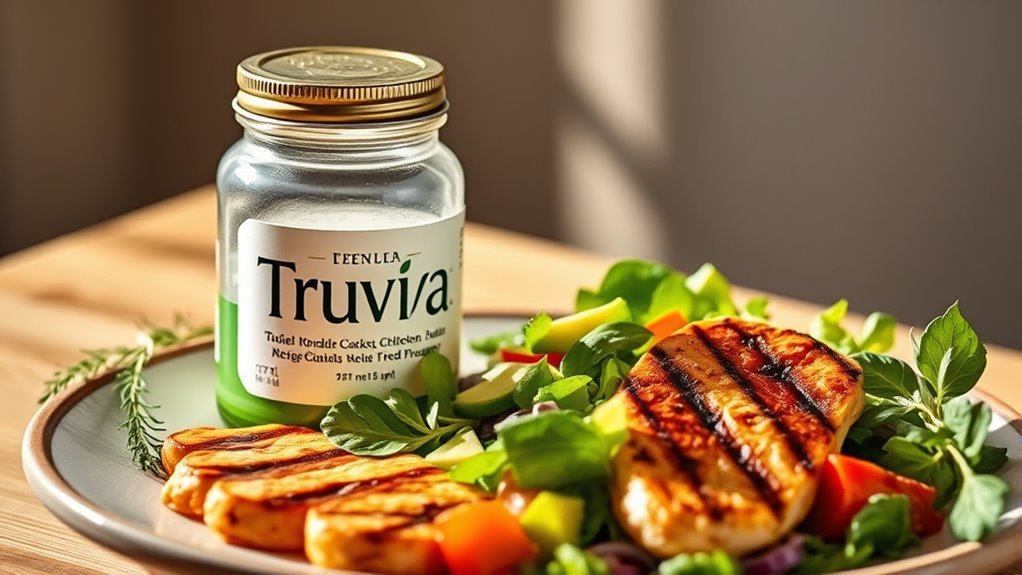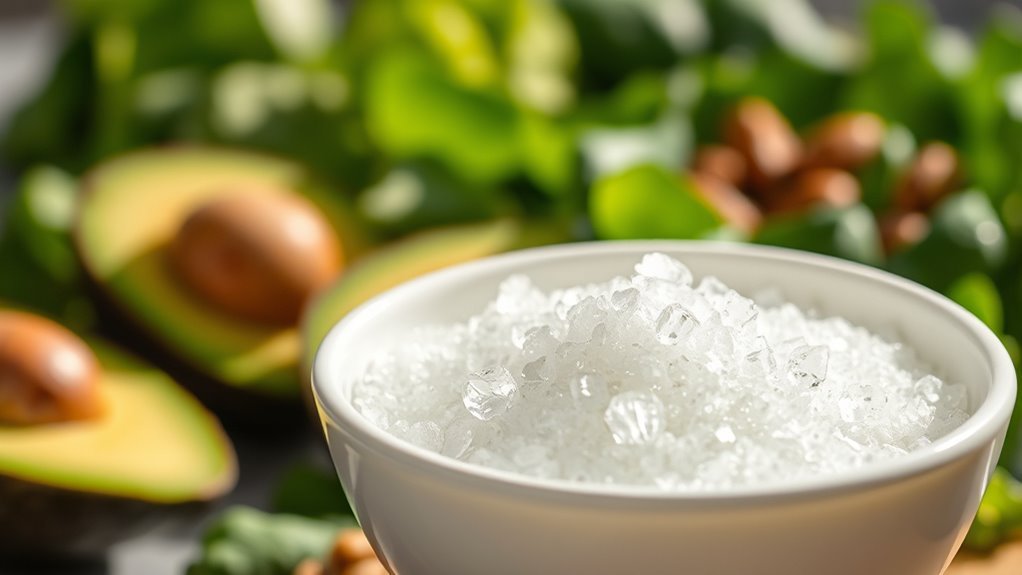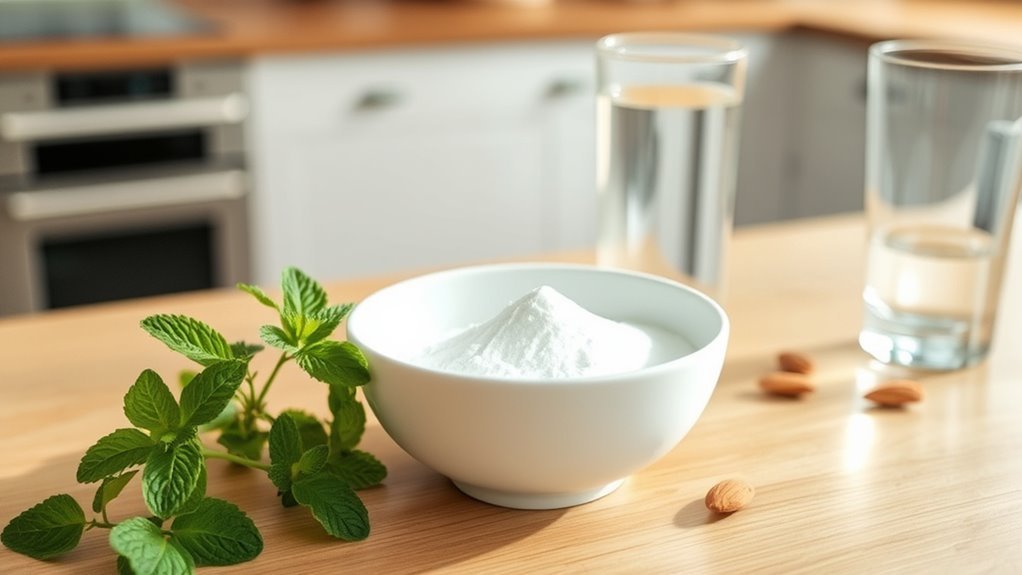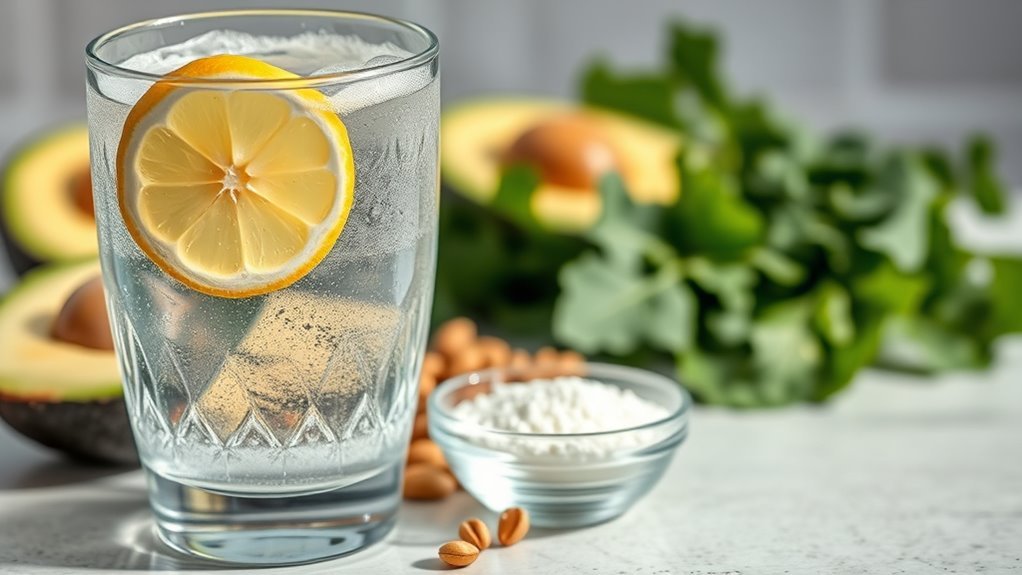Yes, Truvia is keto-friendly. It’s made from erythritol and stevia, providing sweetness with minimal carbohydrates and a low glycemic index that won’t affect your blood sugar levels greatly. With about 4 grams of total carbs per teaspoon, only 0.2 grams count towards net carbs, making it suitable for a ketogenic diet. Moderation is key to enjoy the sweetness without digestive issues. Let’s explore how to incorporate Truvia into your meals and discover its benefits further.
Understanding Truvia’s Ingredients

When it comes to evaluating whether Truvia is keto-friendly, understanding its ingredients is vital. Truvia’s formulation primarily includes erythritol, stevia leaf extract, and natural flavors. Erythritol is a sugar alcohol that’s low in calories and doesn’t greatly impact blood sugar levels, making it a popular choice for those on a ketogenic diet. Stevia, derived from the leaves of the stevia plant, is a natural sweetener that offers sweetness without calories. The combination of these Truvia ingredients provides a sweet taste without added carbohydrates, aligning with keto principles. However, it’s important to take into account your overall dietary intake when incorporating Truvia into your meals. This way, you can enjoy the freedom of flavor while adhering to your dietary goals.
Carbohydrate Content in Truvia

Evaluating the carbohydrate content in Truvia is important for anyone contemplating it as a sweetener on a ketogenic diet. Truvia is primarily made from erythritol, a sugar alcohol that contains negligible calories and carbs. Specifically, it has about 4 grams of carbohydrates per teaspoon, but since erythritol isn’t fully absorbed by the body, it contributes only about 0.2 grams to your net carb count. For those practicing carbohydrate counting, this makes Truvia a viable option. However, it’s essential to take into account all carbohydrate sources in your diet. If you’re aiming for strict keto guidelines, incorporating Truvia in moderation can help you maintain your carb limits while enjoying sweetness without the sugar load.
Impact on Blood Sugar Levels

Although many sweeteners can lead to spikes in blood sugar levels, Truvia’s unique formulation makes it a different choice. As a stevia-based sweetener, it has a low glycemic index, which means it won’t notably affect your blood sugar or insulin response. This can be particularly beneficial for those managing their carbohydrate intake.
Consider these key points:
- Truvia contains erythritol, a sugar alcohol that is low in calories and doesn’t raise blood sugar.
- It can help you satisfy your sweet tooth without the negative effects associated with traditional sweeteners.
- Using Truvia may support your keto lifestyle by keeping blood sugar levels stable.
Truvia and Ketosis Explained
How does Truvia fit into a ketogenic diet? Truvia usage can be a beneficial option for those aiming to maintain ketosis. As a low-calorie sweetener derived from the stevia plant, it contains virtually no carbohydrates, making it unlikely to disrupt your ketone production. Truvia benefits include its ability to satisfy your sweet tooth without spiking blood sugar levels, which is vital for staying in ketosis. By substituting sugar with Truvia, you can enjoy sweet flavors in your meals or beverages while adhering to your diet. However, it’s important to monitor your overall intake, as excessive consumption may lead to digestive discomfort. In moderation, Truvia can be a keto-friendly alternative, allowing you the freedom to enjoy sweetness without guilt.
Comparing Truvia to Other Sweeteners
When considering Truvia alongside other sweeteners, it’s important to analyze its composition in relation to erythritol and other natural alternatives. You’ll want to look at factors like net carbs, as these can considerably impact your keto diet. Understanding these differences can help you make informed choices about your sweetener options.
Erythritol vs. Truvia
As you explore different sweeteners for a keto diet, understanding the differences between erythritol and Truvia can help you make informed choices. Erythritol is a popular sugar alcohol known for its low-calorie content and minimal impact on blood sugar levels. Here are some key points to reflect upon:
- Erythritol benefits: It has a glycemic index of zero, making it ideal for keto diets, and it’s also less likely to cause digestive issues compared to other sugar alcohols.
- Erythritol drawbacks: Some people may experience a cooling sensation or digestive discomfort if consumed in large amounts.
- Truvia: This sweetener contains erythritol along with stevia, providing a different flavor profile and potentially more sweetness.
Understanding these factors can help you choose what works best for your keto lifestyle.
Natural Sweeteners Comparison
While erythritol serves as a popular choice among keto dieters, it’s important to contemplate how Truvia stacks up against other natural sweeteners. Each sweetener has unique health benefits, making it essential for you to choose one that aligns with your dietary goals.
| Sweetener | Health Benefits |
|---|---|
| Truvia | Zero calories, low glycemic index |
| Erythritol | 70% as sweet as sugar, zero calories |
| Stevia | Natural origin, antioxidant properties |
| Monk Fruit | Zero calories, may reduce blood sugar |
| Agave | Low glycemic index, high in fructose |
Net Carbs Analysis
Understanding the net carbs in sweeteners is vital for anyone following a ketogenic diet, especially when comparing Truvia to its counterparts. Truvia contains minimal net carbs, making it a suitable option for keto desserts. Here’s how it stacks up against other sweeteners:
- Stevia: Zero net carbs, ideal for strict keto followers.
- Erythritol: Low in net carbs, often used in truvia recipes.
- Aspartame: Contains negligible carbs but may raise concerns for some consumers.
When you’re crafting truvia recipes or enjoying keto desserts, keeping track of these net carbs guarantees you stay within your daily limits. Overall, Truvia can be a great choice, but it’s always good to compare it with other options available to you.
Recommended Serving Sizes
When it comes to using Truvia on a keto diet, knowing the recommended serving sizes is essential for maintaining your carb intake. Truvia is a blend of stevia extract and erythritol, which means it can be a low-calorie sweetener option. For effective usage, it’s generally advised to start with a serving size of about one teaspoon, equivalent to 4 grams. This provides a sweet taste without considerably impacting your daily carb limit. Remember, moderation is key; exceeding this amount may lead to unwanted effects on your blood sugar levels. Always check the packaging for specific guidelines, as different products may vary. By adhering to these recommended serving sizes, you can enjoy Truvia while staying aligned with your keto goals.
Potential Side Effects
Although many people find Truvia to be a suitable sweetener for their keto diet, it’s important to be aware of potential side effects. While generally considered safe, some users report experiencing issues such as:
Truvia may be a keto-friendly sweetener, but it’s crucial to be aware of possible side effects.
- Gastrointestinal discomfort: Consuming too much Truvia can lead to bloating, gas, or diarrhea.
- Allergic reactions: Rarely, some individuals may have an allergy to components in Truvia, leading to skin rashes or other symptoms.
- Blood sugar fluctuations: Although it’s low in calories, some people may still notice changes in blood sugar levels.
Being mindful of these potential side effects can help you make informed choices about your sweetener options. Always consider your body’s unique response when incorporating any new ingredient into your diet.
Incorporating Truvia Into Your Keto Meal Plan
To successfully incorporate Truvia into your keto meal plan, it’s important to reflect on how it can enhance both flavor and adherence to your dietary goals. Truvia can sweeten your favorite keto recipes without adding carbs, making it a suitable choice for desserts, beverages, and sauces. Consider experimenting with various Truvia recipes, like low-carb cheesecake or sugar-free beverages, to keep your meals exciting. You might also explore Truvia alternatives if you’re looking for different flavor profiles or health benefits. Remember to monitor your total carb intake, as even low-carb sweeteners can impact your dietary limits. By thoughtfully using Truvia, you can enjoy delicious meals while staying committed to your keto lifestyle.
Personal Experiences and Testimonials
Many individuals on a keto diet have shared their experiences with Truvia, noting how it fits into their lifestyle without derailing their progress. Personal stories and user reviews highlight several key points:
- Many appreciate the sugar-like sweetness without the carbs.
- Some report that it helps satisfy cravings for sweets, making it easier to stick to their diet.
- Others mention using Truvia in various recipes, enhancing flavor without guilt.
These testimonials suggest that Truvia can be a helpful tool for those seeking to maintain a ketogenic lifestyle. By incorporating it into meals and treats, users often find they can enjoy the freedom of sweetness while staying on track with their health goals. It’s worth considering how it might work for you.
Frequently Asked Questions
Is Truvia Suitable for a Vegan Diet?
Yes, Truvia is suitable for a vegan diet. Its main ingredient, erythritol, is derived from fermented plant sources, while stevia leaf extract is also plant-based. This makes Truvia a great alternative for those seeking vegan-friendly sweeteners. However, it’s always important to check specific product labels for any additives that might not be vegan. There are plenty of other vegan alternatives, like agave syrup or coconut sugar, if you’re looking for variety.
Can Truvia Be Used in Baking?
Yes, you can use Truvia in baking! When you’re looking for sugar substitutes, Truvia’s a great option because it’s much sweeter than sugar, so you’ll need less. A common baking tip is to reduce the amount of other liquids in your recipe since Truvia can add moisture. Just remember, while it works well in many recipes, the texture might differ slightly compared to traditional sugar, so some experimentation may be needed.
Does Truvia Contain Any Allergens?
Truvia doesn’t contain common allergens like gluten, nuts, or dairy, making it a safer choice for many. Its ingredients include erythritol, stevia leaf extract, and natural flavors, which are generally well-tolerated. However, some individuals might experience Truvia side effects like digestive discomfort due to erythritol. It’s always wise to check labels and consult with a healthcare professional if you’re concerned about potential allergens in any product you choose. Enjoy your sweetening freedom!
What Is Truvia’s Shelf Life?
Truvia’s shelf life is generally about two years when stored properly. To guarantee its freshness, keep it in a cool, dry place, away from direct sunlight and moisture. If you notice any changes in color, smell, or taste, it’s best to discard it, as those could indicate expiration. By following proper Truvia storage guidelines, you can enjoy its sweetness without worrying about spoilage for a significant amount of time.
Can Children Use Truvia Safely?
Yes, children can use Truvia safely, but there are some safety concerns to take into account. While it’s generally regarded as safe, moderation is key for children’s health. Some studies suggest that excessive consumption of sugar substitutes may affect appetite or gut health. It’s best to consult with a pediatrician before introducing any sweeteners into a child’s diet, ensuring that you make informed choices for their overall well-being. Balance and moderation should always guide your decisions.


